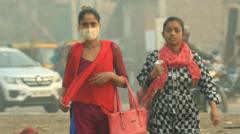
Delhi’s Air Quality Crisis: A Suffocating Emergency
Delhi is experiencing an unprecedented air pollution crisis, with air quality monitors recording pollution levels reaching a staggering 1,500 on the Air Quality Index (AQI) – 15 times higher than the World Health Organization’s recommended safe breathing levels. The toxic air has prompted widespread disruption and urgent government interventions.
The pollution has severely impacted daily life, forcing authorities to implement drastic measures. Schools have been closed, construction work banned, and non-essential truck entry into the city restricted. Additionally, the government has mandated that 50% of office staff work from home and prohibited the use of coal, firewood, and non-emergency diesel generators.
This environmental emergency is not new. Every winter, from October to January, Delhi and surrounding northern Indian states experience hazardous air quality due to a combination of factors including low temperatures, smoke, dust, low wind speed, vehicular emissions, and widespread crop stubble burning.
Delhi’s Chief Minister Atishi has declared the situation a “medical emergency,” specifically highlighting the unchecked stubble burning in neighboring states like Haryana, Uttar Pradesh, and Bihar. She accused the ruling Bharatiya Janata Party (BJP) of failing to address the escalating pollution problem over the past five years. The BJP, in turn, has blamed the city’s ruling Aam Aadmi Party (AAP) for ineffective pollution control.
The health implications are severe. According to WHO standards, AQI values above 300 are considered hazardous. At current levels, residents are experiencing significant respiratory distress. Social media is filled with accounts of people struggling to breathe, with one user describing indoor spaces as feeling like a “gas chamber” despite multiple air purifiers.
Residents are expressing growing frustration, with some calling for peaceful mass protests to draw attention to the toxic air quality. The situation is not isolated to Delhi; nearby Lahore, Pakistan, recently also recorded pollution levels exceeding 1,000 on the AQI.
Experts warn that the situation could worsen in the coming days, suggesting that even more stringent measures might be necessary to combat the pollution crisis. The recurring nature of this problem highlights the urgent need for comprehensive, long-term environmental strategies.
The pollution crisis represents a complex challenge involving environmental, agricultural, political, and public health dimensions. While short-term measures provide temporary relief, addressing the root causes of air pollution requires coordinated efforts from multiple stakeholders, including state governments, agricultural sectors, and urban planning authorities.
As Delhi’s residents continue to struggle with the toxic air, the situation underscores the critical importance of sustainable environmental policies and immediate action to protect public health.









